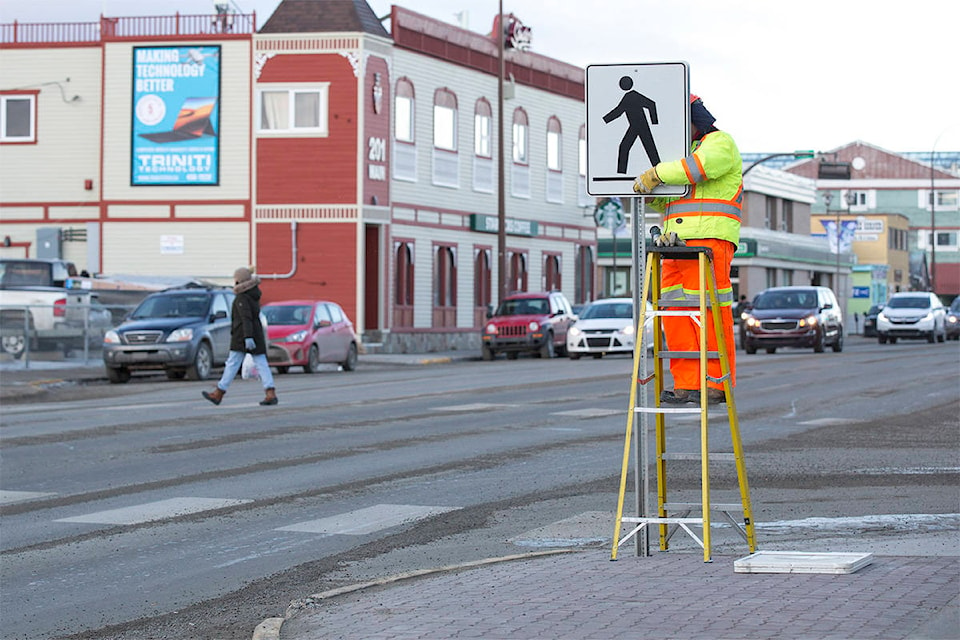Creating safer city roads is an ongoing effort by the city, but any changes take time, says city engineer Taylor Eshpeter.
Eshpeter spoke in a Dec. 16 interview, highlighting how decisions on the placement of crosswalks, speed limits, where traffic lights should be added and the design of city streets are made taking into account all who use the roads — pedestrians, cyclists, or drivers.
The issue — particularly for Second Avenue — has been highlighted since November when 48-year-old Merle Gorgichuk was struck and killed while crossing Second Avenue at the crosswalk at Elliott Street.
Whitehorse city council members have questioned city staff on the road’s safety, with councillors Steve Roddick and Laura Cabott arguing action is needed and major changes required to slow down traffic on the busy street.
As Eshpeter explained, while the city continually looks at transportation issues and road safety, it takes time for initiatives to get underway with much of the work involving studying traffic flow, road use and more.
For Second Avenue in particular, he said, the city began a corridor study in late 2018 with a draft expected to be finished in early 2020.
It is similar to other corridor studies the city has done in the past for other major roadways like Lewes and Hamilton boulevards.
The report will look at the current state of Second Avenue and identify issues, how improvements could be made to the safety of the street and prioritize those actions, he said.
There will likely be a number of potential options to consider that could improve the safety of the road such as road reconfiguration.
It would also be important to have the public buy-in to any changes in the roadway as it will have a major impact on movement through the area.
“With everything there’s always trade-offs,” he said.
Some convenience may have to be given up in the interest of safer road features, Eshpeter said.
As the city works towards the Second Avenue corridor study, it is also anticipating developing a new transportation master plan.
“What really guides us is our transportation master plan,” Eshpeter said.
That’s expected to be done in 2021, pending budget approvals.
And while those larger planning projects are in the works, the city’s traffic committee continues to deal with ongoing issues throughout Whitehorse.
The committee is made up of representatives from city departments like engineering, bylaw, operations (essentially any involved in working on city roads) as well as representatives from the RCMP and the territory’s motor vehicle’s branch.
It’s the traffic committee that’s the first point of contact for many wanting to bring a traffic concern to the city.
Traffic calming, more crosswalks and better lighting top the lists of what many are seeking from the city.
As it does for new road construction, the city uses guidelines developed by the Transportation Association of Canada to determine exactly where crosswalks are placed, lighting and other details.
While the city may take action on an issue, it can be months or even years before any on-the-ground work happens, Eshpeter said.
The traffic committee may do a warrant analysis after hearing the concerns of those requesting a crosswalk or traffic-calming measures be put in place.
That involves tracking traffic and the number of people crossing at the intersection at various times of day and so on and then looking at the guidelines established by the Transportation Association of Canada to see if a crosswalk is warranted.
At that point the issue may become a matter for the next capital budget, which could take months to be approved and then onto the next warm season before that work can be done.
“It’s always subject to budget,” he said.
The guidelines set by the Transportation Association of Canada involve a number of factors in determining which traffic controls are needed such as the amount of traffic as well as other roadway users, what’s in the area (for example a school or park may make a difference) and more, Eshpeter said.
Other times, minor requests like the addition of a sign can happen fairly quickly depending on the season.
While it can take a considerable amount of time for work to begin on any initiative, Taylor was quick to highlight a couple of projects that have happened or are in the works for the near future.
A crosswalk was added to Falcon Drive at Finch Crescent a few years ago and the Fourth Avenue crosswalk at the Tags store is slated to have an overhead light added in 2020, he said.
In some cases as well work may not be warranted at the time the city looks at it, but it stays on the city’s radar for the future should the area become busier.
Eshpeter said the city recently looked at potential ideas for Chilkoot Way, but found they weren’t warranted at this time. If upgrades are made to the roadway in the future though for other reasons, officials will likely consider making crossing improvements then.
Safety improvements around schools in the city are also being contemplated for a few years down the road.
Along with the ongoing efforts to look at safety features on the roads, Eshpeter said the city offers a number of tips for pedestrians, cyclists and drivers on its website to stay safe on the roads.
He emphasized working towards road safety is a combination of the built environment, education and enforcement which is carried out by the RCMP.
Officials with the Yukon RCMP did not respond to a request for comment for this story.
Contact Stephanie Waddell at stephanie.waddell@yukon-news.com
